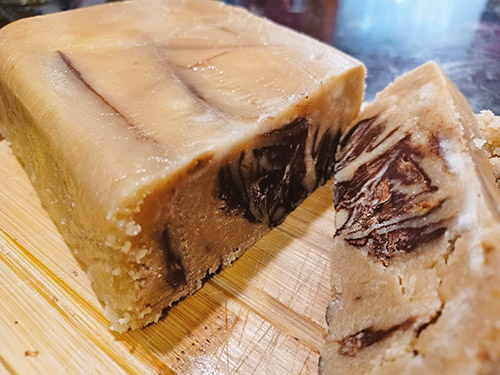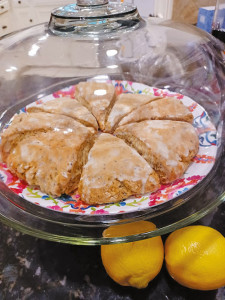
Parshat Bechukotai inspiration:
“Any tithe of the land, of the seed of the land, of the fruit of the tree, belongs to Hashem: It is holy to Hashem.”
Lemon and poppy seed scones! Seed of the land—check. Fruit of the tree—check. And I have been looking forward to trying my hand at scones.

For this recipe, I mixed the ingredients with the dough blade in a food processor. It can also be made with a pastry cutter or even two forks by hand. You are basically making a leavened shortcrust pastry, so you can choose whatever method you prefer to cut margarine into flour.
Most scone recipes also call for buttermilk, which is obviously challenging for the pareve baker. The buttermilk activates the leaveners and softens the gluten to create the ideal structure. The same chemical reaction can be achieved by mixing any milk substitute with an acid. Because we aren’t actually curdling milk it won’t have identical flavor properties, but you still end up with a tasty scone with good structure. I mixed ½ cup unsweetened almond milk with 1½ tsp lemon juice and let it sit while I assembled the other ingredients.
Lemon and Poppy Seed Scones
- 4 cups all-purpose flour, plus a little for kneading
- ½ cup sugar
- 2 Tbsp baking powder
- 1 tsp baking soda
- 3 Tbsp poppy seeds
- Grated lemon zest of one medium lemon (~1-2 tsp)
- ½ cup margarine, cubed
- 2 eggs
- ½ cup “buttermilk” (1/2 cup pareve milk substitute with 1½ tsp lemon juice)
- 2 tsp vanilla extract
- ¾ tsp lemon extract
- Glaze
- 1½ cups confectioner’s sugar
- ½ tsp vanilla extract
- The juice of half of one medium lemon (~1-2 Tbsp juice)
- 2 Tbsp pareve milk substitute (I used almond milk)
1. Have a kneading surface ready. Also have plastic wrap ready—the dough will need to chill in the refrigerator. You will also need a baking sheets and parchment paper eventually, but they don’t need to be ready just yet.
2. Add the dry ingredients to the bowl of the food processor fitted with a dough blade: flour, sugar, baking powder, baking soda, poppy seeds and lemon zest. Pulse it briefly to combine evenly.
3. Add the cubed margarine to the dry ingredients. Pulse several times until the mixture has unevenly sized crumbs.
4. In a spouted cup (like a liquid measuring cup), combine the wet ingredients: eggs, vanilla extract, lemon extract and “buttermilk.” Pour the wet ingredients into the food processor while pulsing. Pulse until the mixture starts to come together as a shaggy dough. It won’t be smooth and will probably have many crumbs still.
5. Turn the shaggy and crumbly dough onto a lightly floured kneading surface. Knead, integrating all the crumbs together, until the dough is almost smooth. It won’t be nearly as smooth or stretchy as challah dough, but it should stay together as you fold it.
6. Divide the dough evenly into two balls and flatten the balls into discs about 1 to 1½” thick. Wrap the discs individually in plastic wrap and chill in the refrigerator for at least 45 minutes.
7. Prepare two baking sheets with parchment paper and heat oven to 425°F.
8. Remove one disc from the refrigerator. Remove the plastic wrap and place it on a lightly floured surface, smoothing the edges. Sprinkle a little flour on top and use a floured rolling pin to roll in into a 8-9” circle. Smooth the edges as much as possible. With a long knife or cutter, cut the circle first into quarters, and then into eighths. You should end up with 8 even wedges.
9. Transfer to a baking sheet and bake in the oven at 425°F for 5 minutes. Lower the temperature to 350°F and bake for another 15-20 minutes, rotating partway through, until the edges are lightly brown. Remove from the oven and let cool on a rack.
10. Re-set the oven temperature to 425°F and repeat steps 8 and 9 for the second disc.
11. Make the glaze by whisking all the glaze ingredients together: confectioner’s sugar, vanilla extract, lemon juice and pareve milk substitute until a smooth and slightly thick liquid is achieved. Holding a cooled scone upside down, dip the top into the glaze and place the scone right-side-up on parchment paper until the glaze solidifies. Repeat for each scone. You will have excess glaze. My kids enjoyed drizzling the excess all over the scones “for decoration.” Why not?
Parshat Bamidbar inspiration:
“As the Lord commanded Moses, so did he count them in the Sinai desert… All the children of Israel were counted according to their fathers’ houses, from 20 years and upward, all who were fit to go out to the army.”
Halva always brings to mind Israel the country, and those who protect her. May He who blessed our ancestors, Abraham, Isaac and Jacob, bless the soldiers of the Israel Defense Forces and the security personnel who stand guard over our country and the cities of our God, from the Lebanese border to the Egyptian wilderness and from the Mediterranean Sea to the edges of the desert—or wherever they might be—on land, in the air or at sea.
There are many halva recipes, and endless variations, but I chose a straightforward one by Shoshona Ohriner that was published by https://jamiegeller.com/recipes/marble-halvah/. I made just a few tweaks in the technique that worked better for me. Make it at least a day in advance so the sugar crystals can fully develop, resulting in a halva that crumbles a little less.
Marble Halva
- 2¼ cups (1 lb.) sugar
- Pinch of salt
- ½ cup cold water
- 15-16 oz. pure sesame tehini (I had the smoothest results using Joyva™, not surprizingly.*)
- 1 tsp vanilla extract
- 4 -5 oz. dark chocolate chips or chunks, melted
1. Prepare a loaf pan by lining with plastic wrap, leaving a generous overhang on each side. Melt the chocolate in a small bowl (I melted it in the microwave, a few 15-second pulses at a time, stirring until smooth). Prepare a stand mixer with a paddle attachment.
2. In a medium saucepan, place the water, sugar, and salt and bring to a boil on medium-high heat, stirring occasionally to make sure the sugar is all dissolving. Once the mixture comes to a boil do not stir it again. Place a candy thermometer in the sugar mixture and cook to 240°F or soft-ball stage.
3. While the sugar syrup is cooking, place the tehini in a small sauce pan and heat it until it is quite warm but not yet boiling. Stir frequently to prevent it from burning or sticking to the bottom of the pan.
4. When the sugar mixture is about to reach temperature, bring the bowl of the mixer over to the stove, pour the warm tehini directly to the bowl of a stand mixer and add the vanilla extract. Immediately add the hot sugar mixture.
5. Working quickly, place the bowl back in the stand mixer with the paddle attachment, and turn it on the lowest setting and mix just until the mixture starts to look a bit grainy and loses some of its shine—this takes just 30-50 seconds. Be careful not to overbeat the mixture or it will start to set in the bowl and become a crumbly mess rather than a creamy finished candy.
6. Pour the mixture immediately into the prepared loaf pan. Drizzle or scoop the melted chocolate across the halva and give it a few pokes and stirs with a spatula until the chocolate is swirled through. Fold the plastic wrap over the halva and let cool at room temperature until set, approximately one hour. Store, well wrapped in plastic, in an airtight container in the refrigerator for at least 24 hours, preferably longer, for the sugar crystals to develop.
7. Slice it with a long, sharp knife to minimize crumbling. Gobble up the crumbs and pretend they didn’t happen.
* Joyva’s first product in 1907 was halva, and it remains the largest halva producer in the U.S. today (according to Wikipedia).
Follow me @EdibleParsha on Facebook to see each recipe on the Monday of each parsha week for plenty of time to prepare it for Shabbat!










